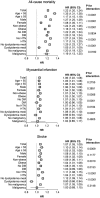Cholesterol variability and the risk of mortality, myocardial infarction, and stroke: a nationwide population-based study
- PMID: 29069458
- PMCID: PMC6251576
- DOI: 10.1093/eurheartj/ehx585
Cholesterol variability and the risk of mortality, myocardial infarction, and stroke: a nationwide population-based study
Abstract
Aims: A high visit-to-visit variability in cholesterol levels has been suggested to be an independent predictor of major adverse cardiovascular events in patients with coronary artery disease (CAD). Because whether this notion applies to general population is not known, we aimed to investigate the associations between total cholesterol (TC) variability and the risk of all-cause mortality, myocardial infarction (MI), and stroke.
Methods and results: We identified 3 656 648 subjects without a history of MI and stroke who underwent ≥3 health examinations from 2002 to 2007 in the Korean National Health Insurance System cohort. Total cholesterol variability was measured using the coefficient of variation (CV), standard deviation (SD), and variability independent of the mean (VIM). There were 84 625 deaths (2.3%), 40 991 cases of MI (1.1%), and 42 861 cases of stroke (1.2%) during the median follow-up of 8.3 years. There was a linear association between higher TC variability and outcome measures. In the multivariable adjusted model, the hazard ratios and 95% confidence intervals comparing the highest vs. lowest quartiles of CV of TC were 1.26 (1.24-1.28) for all-cause mortality, 1.08 (1.05-1.11) for MI, and 1.11 (1.08-1.14) for stroke, which was independent of mean TC levels and the use of lipid-lowering agents. The results were consistent when modelling variability of TC using SD and VIM, and in various sensitivity analyses.
Conclusion: High variability in lipid levels is associated with adverse health-related outcomes. These findings suggest that lipid variability is an important risk factor in the general population.
Keywords: Cholesterol; Mortality; Myocardial infarction; Stroke; Variability.
Published on behalf of the European Society of Cardiology. All rights reserved. © The Author 2017. For permissions, please email: journals.permissions@oup.com.
Figures





Comment in
-
Cholesterol variability: a marker for increased risk or a risk factor?Eur Heart J. 2017 Dec 21;38(48):3567-3568. doi: 10.1093/eurheartj/ehx656. Eur Heart J. 2017. PMID: 29140424 No abstract available.
References
-
- Kim DH, Lipsitz LA, Ferrucci L, Varadhan R, Guralnik JM, Carlson MC, Fleisher LA, Fried LP, Chaves PH.. Association between reduced heart rate variability and cognitive impairment in older disabled women in the community: women’s health and aging study I. J Am Geriatr Soc 2006;54:1751–1757. - PMC - PubMed
-
- Muntner P, Shimbo D, Tonelli M, Reynolds K, Arnett DK, Oparil S.. The relationship between visit-to-visit variability in systolic blood pressure and all-cause mortality in the general population: findings from NHANES III, 1988 to 1994. Hypertension 2011;57:160–166. - PubMed
-
- Tsuji H, Larson MG, Venditti FJ Jr., Manders ES, Evans JC, Feldman CL, Levy D.. Impact of reduced heart rate variability on risk for cardiac events. The Framingham Heart Study. Circulation 1996;94:2850–2855. - PubMed
Publication types
MeSH terms
Substances
LinkOut - more resources
Full Text Sources
Other Literature Sources
Medical
Miscellaneous

